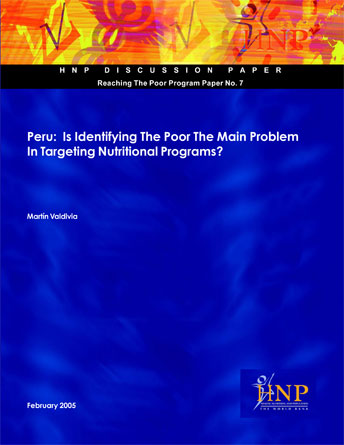Peru: is identifying the poor the main problem in targeting nutritional programs?
| Year | : | 2005 |
|---|---|---|
| Author/s | : | Martin Valdivia |
| Area/s | : | Methodologies for research and evaluation of policy and programmes, Health and nutrition |
[2005] VALDIVIA, Martín. Peru: is identifying the poor the main problem in targeting nutritional programs?. Washington, D.C.: The International Bank for Reconstruction and Development; World Bank. 23 p. HNP Discussion Paper, Reaching the Poor Program Paper, 7.
This study analyzes the targeting performance of three public nutritional programs for children in Peru: the Vaso de Leche (VL – glass of milk), the School Breakfast (SB) and an aggregate of programs (ECHINP) that focuses on the nutrition of children under 3.
I find these programs to have large leakages with between 40% and 50% of their beneficiaries falling outside the target group either because they are not poor or because they are outside the age range. These leakages are larger for the VL program (50%) and in urban areas, where poverty rates are relatively lower. The robustness analysis presented here argues against putting too much priority on the improvement of poverty maps and means-tested instruments, and in favor of redefining delivery protocols that are consistent with the program’s objectives and in addressing political distortions in their management so that proper exit rules for old beneficiaries become feasible.
There are two key findings. First, the age restriction is found to be very important for programs that allow for consumption within the household (the VL program and the ECHINP aggregate). Omitting that restriction changes the relative ordering significantly: the VL program stops being the one with the worst targeting performance and the ECHINP aggregate becomes by far the program with lowest leakage (17%).
This result can be argued to be not bad if we consider that poverty and nutritional vulnerability is not an individual problem but a family problem. The policy implication comes from the fact that ignoring these intra-household arrangements reduces the size of the transfer per capita and limits the possibility for them to have a nutritional impact on the target population. Second, the paper finds that the SB and VL programs are very pro-poor at the margin despite having a very mediocre targeting performance on average.
This result suggests the need for caution in making decisions based on the average targeting performance of programs, because they could show large leakages on average, but a cut (expansion) could still damage (benefit) the poor more than proportionately. An additional policy implication is that improving the targeting of these programs requires changes in the political base that supports them.






